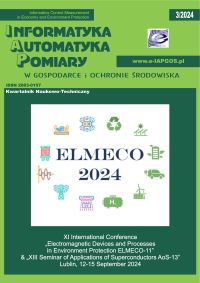BADANIE METOD OPTYMALIZACJI OBLICZEŃ STOSOWANYCH W TWORZENIU GIER KOMPUTEROWYCH
Natali Fedotova
n.fedotova@cs.sumdu.edu.uaSumy State University (Ukraina)
https://orcid.org/0000-0001-9304-1693
Maksim Procenko
Sumski Uniwersytet Stanowy (Ukraina)
https://orcid.org/0009-0008-9575-8549
Iryna Baranowa
Sumski Uniwersytet Stanowy (Ukraina)
http://orcid.org/0000-0002-3767-8099
Switłana Waszczenko
Sumski Uniwersytet Stanowy (Ukraina)
http://orcid.org/0000-0002-7021-2629
Yaroslava Dehtiarenko
Politechnika Lubelska (Polska)
http://orcid.org/0009-0004-9455-7092
Abstrakt
W dziedzinie tworzenia gier komputerowych istnieje wiele metod optymalizacyjnych, które pozwalają znacznie zredukować liczbę obliczeń, jakie wykonuje system gry podczas renderowania, co z kolei pozwala na wyświetlanie coraz bardziej realistycznej grafiki. W pracy przeprowadzono analizę ogólnych metod optymalizacji stosowanych w silniku gier Unreal Engine, takich jak Distance Culling, Occlusion Culling, Frustum Culling, LODs, Level Streaming oraz Nanite System. Zidentyfikowano główne czynniki, które mają znaczenie: zużycie zasobów, jakość wizualna, liczba obiektów i skalowalność. Wyniki badań pokazują, że prawidłowo zastosowane metody optymalizacji mogą poprawić wydajność gry i zmniejszyć obciążenie systemu obliczeniowego, co jest istotne zarówno pod względem funkcjonalnym, jak i estetycznym.
Słowa kluczowe:
UE5, metody optymalizacji, tworzenie gierBibliografia
Akenine-Moller T. et al.: Real-Time Rendering. 4th еd., A K Peters/CRC Press, 2018. 1200.
DOI: https://doi.org/10.1201/b22086
Google Scholar
Akmalia R. et al.: TLS for generating multi-LOD of 3D building model. IOP Conference Series: Earth and Environmental Science 2014.
DOI: https://doi.org/10.1088/1755-1315/18/1/012064
Google Scholar
Alvarez A.: Exploring Game Design through Human-AI Collaboration, 2022.
Google Scholar
Dickinson C.: Unity 5 Game Optimization. Packt Publishing, 2015.
Google Scholar
Gregory J.: Game Engine Architecture. 3rd еd., CRC Press, 2019.
DOI: https://doi.org/10.1201/9781315267845
Google Scholar
Hasenfratz J.-M. et al.: A survey of Real-Time Soft Shadows Algorithms. Computer Graphics Forum 4(22), 2003, 753–774.
DOI: https://doi.org/10.1111/j.1467-8659.2003.00722.x
Google Scholar
Hogan J. et al.: Analyzing Performance Issues of Virtual Reality Applications. ArXiv 2022, (abs/2211.02013).
Google Scholar
Johansson M., Roupé M., Bosch-Sijtsema P.: Real-time visualization of building information models (BIM). Automation in Construction 54, 2015.
DOI: https://doi.org/10.1016/j.autcon.2015.03.018
Google Scholar
Penty C.: Behind the Scenes of The Cavern UE5 Cinematic Visual Tech Test SIGGRAPH ’22. New York, USA: Association for Computing Machinery, 2022.
DOI: https://doi.org/10.1145/3532833.3538677
Google Scholar
Sekulic D.: Efficient Occlusion Culling Addison-Wesley Professional, 2018.
Google Scholar
Xu H. et al.: Efficient visualization of 3D city scenes by integrating the GIS and Unreal Engine. SPIE, 2023. 125510I.
DOI: https://doi.org/10.1117/12.2668104
Google Scholar
Unreal Engine 5 Documentation: Visibility and Occlusion Culling. https://docs.unrealengine.com/5.1/en-US/visibility-and-occlusion-culling-in-unreal-engine/ (available: 02 12.07.2022).
Google Scholar
Unreal Engine 4 Documentation: Creating and Using LODs. https://docs.unrealengine.com/4.26/en-US/WorkingWithContent/Types/StaticMeshes/HowTo/LODs/ (available: 12.07.2022).
Google Scholar
Unreal Engine 4 Documentation: Level Streaming Overview. https://docs.unrealengine.com/4.27/en-US/BuildingWorlds/LevelStreaming/Overview/ (available: 20.07.2022).
Google Scholar
Unreal Engine 5 Documentation. Nanite Virtualized Geometry. https://docs.unrealengine.com/5.0/en-US/nanite-virtualized-geometry-in-unreal-engine/ (available: 20.07.2022).
Google Scholar
Unreal Engine 4 Optimization Tutorial, Part 1: https://www.intel.com/content/www/us/en/developer/articles/training/unreal-engine-4-optimization-tutorial-part-1.html (available: 20.09.2022).
Google Scholar
MSI Afterburner: https://ua.msi.com/Landing/afterburner/graphics-cards (available: 20.09.2022).
Google Scholar
Autorzy
Natali Fedotovan.fedotova@cs.sumdu.edu.ua
Sumy State University Ukraina
https://orcid.org/0000-0001-9304-1693
Profesor nadzwyczajny na Wydziale Technologii Informacyjnych Sumskiego Uniwersytetu Państwowego na Ukrainie.
Autorzy
Maksim ProcenkoSumski Uniwersytet Stanowy Ukraina
https://orcid.org/0009-0008-9575-8549
Bachelor and master of the Department of Information Technologies, Faculty of Electronics and Information Technologies, Sumy State University. Middle C++ developer at MoonMana Games
Autorzy
Iryna BaranowaSumski Uniwersytet Stanowy Ukraina
http://orcid.org/0000-0002-3767-8099
Associate professor of the Department of Information Technology, Sumy State University, Ukraine. Author and co-author of more than 30 scientific papers. Research interests: 3D modeling, visualization, animation, software application for the development of systems of automated design, e-learning systems.
Autorzy
Switłana WaszczenkoSumski Uniwersytet Stanowy Ukraina
http://orcid.org/0000-0002-7021-2629
Associate professor of the Department of Information Technology, Sumy State University, Ukraine.
Research interests: software engineering, use of modern information technologies (in particular, system modeling, structural-functional analysis) for the development of application software in various fields of activity, e-learning systems, and visualization.
Autorzy
Yaroslava DehtiarenkoPolitechnika Lubelska Polska
http://orcid.org/0009-0004-9455-7092
Student of the Faculty of Electrical Engineering and Computer Science, Lublin University of Technology, Poland. The author`s research area focuses on optimization methods, human-computer interaction, real-time systems, computer graphics and simulations.
Statystyki
Abstract views: 301PDF downloads: 296
Licencja

Utwór dostępny jest na licencji Creative Commons Uznanie autorstwa – Na tych samych warunkach 4.0 Miedzynarodowe.
Inne teksty tego samego autora
- Oleksandr Necheporuk, Svitlana Vashchenko, Nataliia Fedotova, Iryna Baranova, Yaroslava Dehtiarenko, ANALIZA METOD REKOMENDACJI TREŚCI W SERWISACH INFORMACYJNYCH , Informatyka, Automatyka, Pomiary w Gospodarce i Ochronie Środowiska: Tom 14 Nr 3 (2024)








